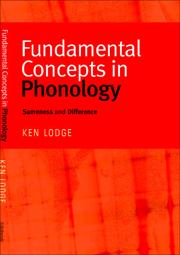Book contents
2 - Sameness and meaningful contrast in phonology
Published online by Cambridge University Press: 05 August 2013
Summary
Similarity of sound is no safe guide to functional identity.
(Firth, Papers in Linguistics)I now want to turn to the specifically linguistic aspect of sameness and difference by looking first at a topic that all phonologists should agree with: the notion of meaningful contrast as the centre of phonological analysis. However, I would like to scrutinize it in a little more detail than is perhaps usual by considering how we, as phonologists, determine what constitutes sameness in phonology and what the consequences of that identification are. I will then elaborate on the topic in the later chapters of the book. As I have tried to show in the first chapter, one of the fascinating things about human beings is the way in which they classify: for the most part, sameness does not mean absolute identity, and sameness in one set of circumstances may be difference in others. To take a simple phonological example, native speakers of English typically identify regular plurality as being the same in all instances, despite the fact that phonetically we have [s], [z] and [iz] as predictable realizations; yet when distinguishing mace and maze native speakers have no difficulty in recognizing the same phonetic difference as marking a meaningful contrast. (Students of phonetics, even those who are quite competent in discrimination and transcription, typically transcribe regular plural forms with [s] even after voiced sounds, for example, [ctogs], and the regular past tense as [d], even after voiceless sounds, for example, [wokd].) The significance of the reinforcement of such classifications by the system of English spelling will be discussed in Chapter 4.
- Type
- Chapter
- Information
- Fundamental Concepts in PhonologySameness and Difference, pp. 14 - 24Publisher: Edinburgh University PressPrint publication year: 2009



